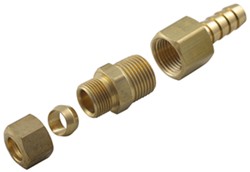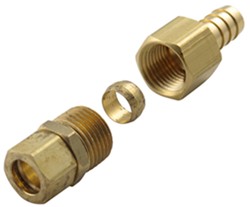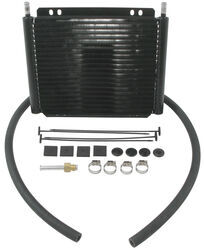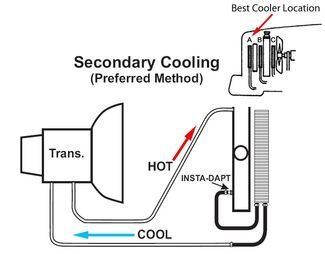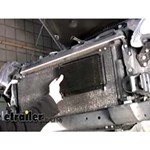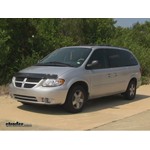
Transmission Cooler Recommendation for a 2006 Chrysler Pacifica
Question:
I have a 2006 Pacifica 3.5 24valve with 110,000 miles. The car is in perfect condition and all maintenance is performed as needed and I have changed the oil every 3000 to 4000 miles since mile one. I now use Max life oil. I had a tow package installed and am pulling a trailer weighing 2800lbs empty, so I’m guessing that I tow 3000 to 3200. Would you recommend a Transmission cooling system and which one? I camp in SC, GA, and FL., so most of my driving is on level ground, no mountains.
asked by: Jim M
Expert Reply:
A transmission cooler is always a good idea if you are towing. Overheating is one of the biggest causes for transmission failure because your transmission relies on the transmission fluid to stay cool. The added stress from towing a trailer on the engine and transmission will cause the transmission fluid to heat up more than normal.
It is a good idea to get the largest transmission cooler possible because transmission fluid cannot be cooled too much, however, you will be limited by the amount of space that is available in front of your AC condenser or radiator.
The Derale Series 8000 Plate-Fin Transmission Cooler, # D13503, is a great idea for your 2006 Chrysler Pacifica. This cooler measures 11 inches wide x 8-3/4 inches tall x 7/8 inches deep. You will want to measure in front of your AC condenser or radiator to make sure you have room to fit this cooler.
This cooler uses an efficient plate-fin design that will prolong the life of your transmission and is Class III rated, meaning it is rated for up to 6,000 lbs.
I have attached two links to articles on transmission coolers as well as an installation video for you to check out. The vehicle in the video is different, but it will give you an idea how to install the cooler.
Our installer uses a compression fitting, # D13032, to install the hoses from the transmission cooler to the transmission cooler lines. Before beginning your installation, I would recommend that you find the location of your transmission lines and measure the outside diameter of the return line. It may be easier for you to cut the return line and install compression fittings depending on the location of the lines.
I have provided links to the 3 sizes of compression fittings that we carry.

Products Referenced in This Question
Derale Transmission Line Compression Fitting Kit - 5/16" Line to 3/8" NPT Barb
- Accessories and Parts
- Transmission Coolers
- Fittings
- 3/8 Inch NPT Hose Barb
- Derale
more information >
Derale Transmission Line Compression Fitting Kit - 3/8" Line to 3/8" NPT Barb
- Accessories and Parts
- Transmission Coolers
- Fittings
- 3/8 Inch NPT Hose Barb
- Derale
more information >
Derale Transmission Line Compression Fitting Kit - 1/2" Line to 1/2" NPT Barb
- Accessories and Parts
- Transmission Coolers
- Fittings
- 1/2 Inch NPT Hose Barb
- Derale
more information >
Product Page this Question was Asked From
Derale Series 8000 Plate-Fin Transmission Cooler Kit w/Barb Inlets - Class III - Efficient
- Transmission Coolers
- Plate-Fin Cooler
- Mid-Size Truck
- SUV
- Van
- Standard Mount
- 11W x 8-3/4T x 7/8D Inch
- With 11/32 Inch Hose Barb Inlets
- Derale
more information >
Featured Help Information
Instructions
Miscellaneous Media

Continue Researching
- Article: Frequently Asked Questions About Transmission Coolers
- Article: Brake Controller 7- and 4-Way Installation Kit (ETBC7)
- Article: Transmission Cooler
- Article: How to Measure for Trailer Hitch Drop
- Q&A: What do the Class Ratings Mean on the Transmission Cooler Pages
- Article: Trailer Wiring Diagrams
- Q&A: 2014 Jeep Grand Cherokee Compatibility with 5000 lb Travel Trailer
- Article: Determining Trailer Tongue Weight
- Q&A: SuperCoils and SumoSprings For Improving Ride Quality On a 2019 Ram 1500 With Truck Bed Camper
- Article: Engine Oil Coolers
- Q&A: Transmission Cooler Recommendation for 2011 Chevy Silverado
- Q&A: What is the Difference Between a 4-Way and 7-Way Trailer Connector
- Q&A: What is the Difference Between a Class II and a Class III Hitch?
- Q&A: Comparing Flex-A-Lite And Derale Transmission Coolers For A 2016 Honda Pilot





